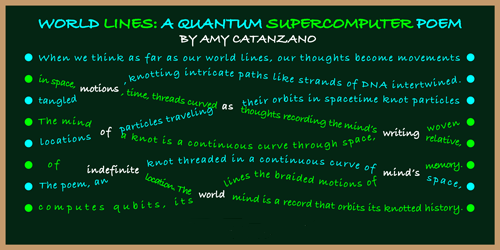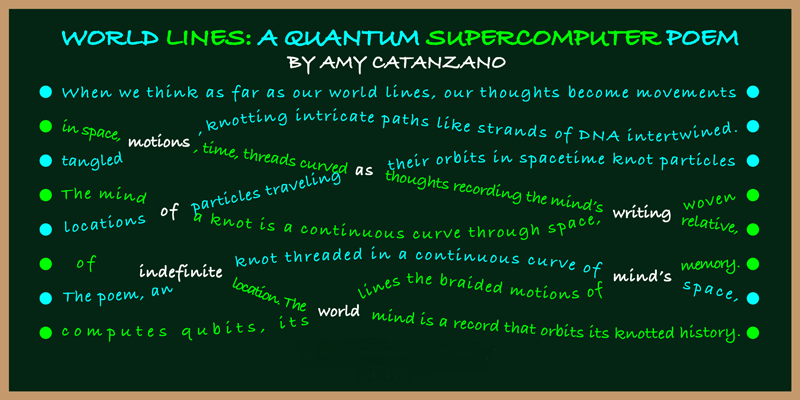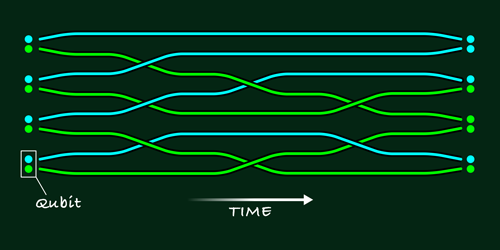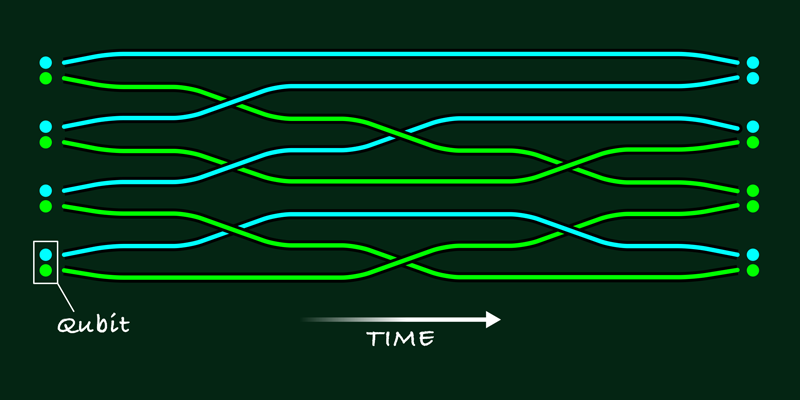Arts & Culture: Poetry Takes on Quantum Physics
The quantum world seems to defy logic. For example, a quantum object arriving at a fork in its path does not have to choose between veering left or right but travels both routes simultaneously instead—an action that is impossible for classical objects, like baseballs and humans. Physicists have a rigorous mathematical language for characterizing quantum behavior, but translating that mathematics into everyday words is tricky. Poet Amy Catanzano thinks that poetry could offer a solution by providing a means to create a new language that might more accurately describe the seemingly indescribable quantum world. She put this idea into practice in her recent poem called “World Lines: A Quantum Supercomputer Poem,” which was inspired by, and incorporates, the physics of a topological quantum computer.
“Poetic language is a hyperbolic language that can inspire fresh ways of seeing and being. It can deconstruct and challenge our assumptions,” says Catanzano. She believes these unique qualities of poetry are well suited for taking on quantum physics, which also challenges our basic conceptions of the physical world.
The basis for Catanzano’s poem, which was written during a week-long residency at the Simons Center for Geometry and Physics at Stony Brook University, New York, is a diagram of a possible architecture for a topological quantum computer. The design contains four quantum bits (qubits), each of which consists of two quasiparticles known as anyons. Calculations are performed by swapping the positions of adjacent anyons in a predetermined sequence. The output of the computation is then contained in the so-called knots and braids created by the intertwining of the anyons’ paths—or, more technically, their world lines.
In her poem, Catanzano replaces the weaving anyons with four poetic couplets, which crisscross over one another. Where two lines intersect, they share a word, a literary device Catanzano used to evoke an anyon knot. These textual knots are like forks in the reader’s path. The text can be read linearly—following each line of text sequentially—or the reader can jump from one line to another when they encounter a textual knot. Different paths through the poem create unique word-braids and lead to different “calculations,” just as in a topological quantum computer.
“World Lines: A Quantum Supercomputer Poem” translates the quantum theory behind a topological quantum computer in both its word choices and its visual structure, a practice Catanzano calls quantum poetics. “My aim was to write a poem that served as an imaginative and rigorous site of interaction between poetry and physics,” she says.
The idea of using literary devices to explain concepts in physics is not a new one. Physicists have long turned to metaphors to break down complex mathematics. The word “entanglement” is one such example. Physicists use the word to evoke the concept of two connected quantum particles, where the manipulation of one affects the state of the other, even if the particles are separated by great distances. But metaphors can be hazardous; they repurpose ordinary language, which can lead to misunderstandings. “The word entanglement suggests that the states of the particles are physically interwoven, braided, or overlapped,” says Catanzano. In actuality, the particles have no physical connection or communication line, as evidenced by numerous quantum physics experiments.
“If you try to extrapolate ordinary language to a world that humans have never directly experienced, it’s very difficult to find expressions that can express this particular reality,” says Luis Álvarez-Gaumé, the Director of the Simons Center and Catanzano’s host during her visit. However, Álvarez-Gaumé notes that this difficulty hasn’t stopped physicists from trying to describe this other world—while also having some fun. His favorite example is the use of “color” and “flavor” to describe quarks. The particles don’t actually have a color or flavor, he chuckles. “When you communicate with the general public they can get very confused.”
Catanzano thinks this confusion could be avoided if poetic thinking were more commonplace. Poetry is a nuanced and complex form of language that goes beyond simple dictionary definitions of individual words. Poems use rhythm, visual structure, line breaks, word order, and other devices to explore invisible worlds, alter the flow of time, and depict the otherwise unimaginable, says Catanzano. For these reasons, she thinks that poetry is a compatible language for quantum theory. This sentiment is echoed by Giuseppe Mussardo, a physicist at the International School for Advanced Studies (SISSA), Italy, and one of Catanzano’s sources of information on topological quantum computers. “Poetry provides a richness of language that could provide new tools for expressing ideas,” says Mussardo. But both he and Álvarez-Gaumé caution that for any new language to gain widespread use by physicists, it would need to accurately capture the mathematics of quantum theory. “Perhaps, eventually, we’ll find some quantum language that is a relatively close description of nature,” says Álvarez-Gaumé. “So far we have failed miserably.”
–Katherine Wright
Katherine Wright is a Senior Editor of Physics.







